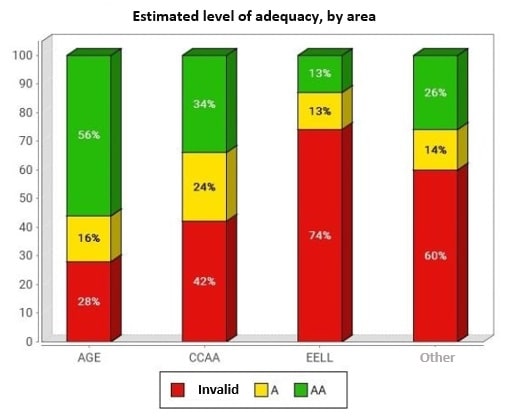

The Website Monitoring results for 2020-2021 have just come in. These results are published in relation to the measures implemented on 20 September 2018, the date Royal Decree 1112/2018 came into force. Regulating the accessibility of public sector web sites and applications, this law transposes Directive (EU) 2016/2102.
Featured among the new measures required by the Royal Decree, is the monitoring, follow-up, and reporting on the status of a given website’s compliance with accessibility norms.
This requires member states to report the results of public sector website monitoring to the European Commission every three years, following the methodology and provisions established for the submission of this report.
This task is performed using two review methods: a simplified method and an in-depth method. These allow for the analysis and review of compliance and the evolution of web accessibility for public sector websites and applications.
Findings from the 2020-2021 Website Monitoring Report
We have analysed the monitoring report results obtained through the Simplified Monitoring Methodology created by the Web Accessibility Observatory.
These results reveal the current disastrous situation of web accessibility at four government levels (state, regional, local, and others).
To better understand the report, we have divided its conclusions into four different sections, two that centre on overall data and two providing information broken down by administrative area (General State Administration, Autonomous Communities, Local Entities, and Others).
Overall estimated level of adequacy
Firstly, the results of the report show that theoverall estimated level of adequacyof the sites under analysis is only Level AA in almost a third of the websites, that is, 32.18%.
Furthermore, only 15.94% attain Level A adequacy, with more than half of the websites analysed (51.88%) being identified as “invalid”.

This data paints a very negative picture of the current situation in website accessibility for public sector websites and apps. Two out of every three websites lack the accessibility implementations that would eliminate existing barriers.
Overall estimated compliance status
Before we look at the website compliance analyses, here is a breakdown of the three conformance levels applied:
- Fully compliant: All verifications other than “does not apply” are assessed as “compliant”.
- Partially compliant: there is a greater number of “compliant” checks than “non-compliant” checks.
- Non-compliant: the number of “non-compliant” checks is greater than or equal to “compliant” checks.
Of the 1,010 websites analysed, only 5.54% were found to be “fully compliant”, an extremely low figure.
68.12% were considered “partially compliant” because they conform to more than half of the checks assessed by the Observatory.
26.34% of the websites were found to be “non-compliant”, in other words, 266 websites fail to conform to the majority of accessibility checks under analysis.

Estimated level of adequacy by administrative area
When we look at accessibility according to administrative area, AGE (General Administration of the State) obtained the best results in terms of consistency with the estimated level of adequacy, with 56% of the websites attaining level AA, 16% at level A, and 28% described as “invalid” status.
In descending order of compliance we find CCAA (Autonomous Communities), EELL (Local Entities), and last, other areas, with the results of the latter two being much more negative.

Bear in mind that we cannot compare the estimated level of adequacy and the estimated compliance status as they measure two very different things.
What this means is that a website can perform well in the estimated level of adequacy metric and poorly in the estimated compliance status metric or vice versa.
This is possible because the “fully compliant” status is more restrictive than Level AA.
Estimated compliance status by area
As regards the estimated compliance status by administrative area, the report shows that AGE performed less poorly than the rest. Although in this area only 75% of the websites were rated as being “partially compliant” compared to 78% of the Autonomous Communities websites, 13% of AGE websites were still assessed as being “fully compliant”, compared to 2% found in other areas. However, these figures are still quite low.
The data on EELL (Local Entities) and other areas show similar results. They performed the poorest in terms of compliance when compared to the above public sector areas. Both stand out for performing poorly, with 38% of their websites being classed as “non-compliant”. This clearly shows that improvement is needed if they wish to attain a higher score in future reviews.

We conclude with a summary showing the website monitoring results for 2020 – 2021.
Only 6% of public sector websites fully comply with the European accessibility directive
The data shows that Spanish Public Sector websites have a long way to go if they wish to reach the level of compliance required by the European directive. These are very poor results, indicating that we need to continue working on accessibility actions that eliminate the barriers that still exist for users with disabilities and older adults on the web.
Would you like to see more relevant data from the report? We will publish a similar article shortly with the conclusions of the monitoring report as they pertain to applications for mobile devices.
If you want to join other institutions and companies committed to accessibility compliance, contact us now, no obligation to purchase! We offer practical demos of inSuit, the best accessibility solution you can find. Right now inSuit is used on public sector websites such as the Sepe and Seguridad Social websites.


